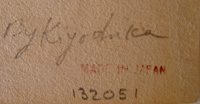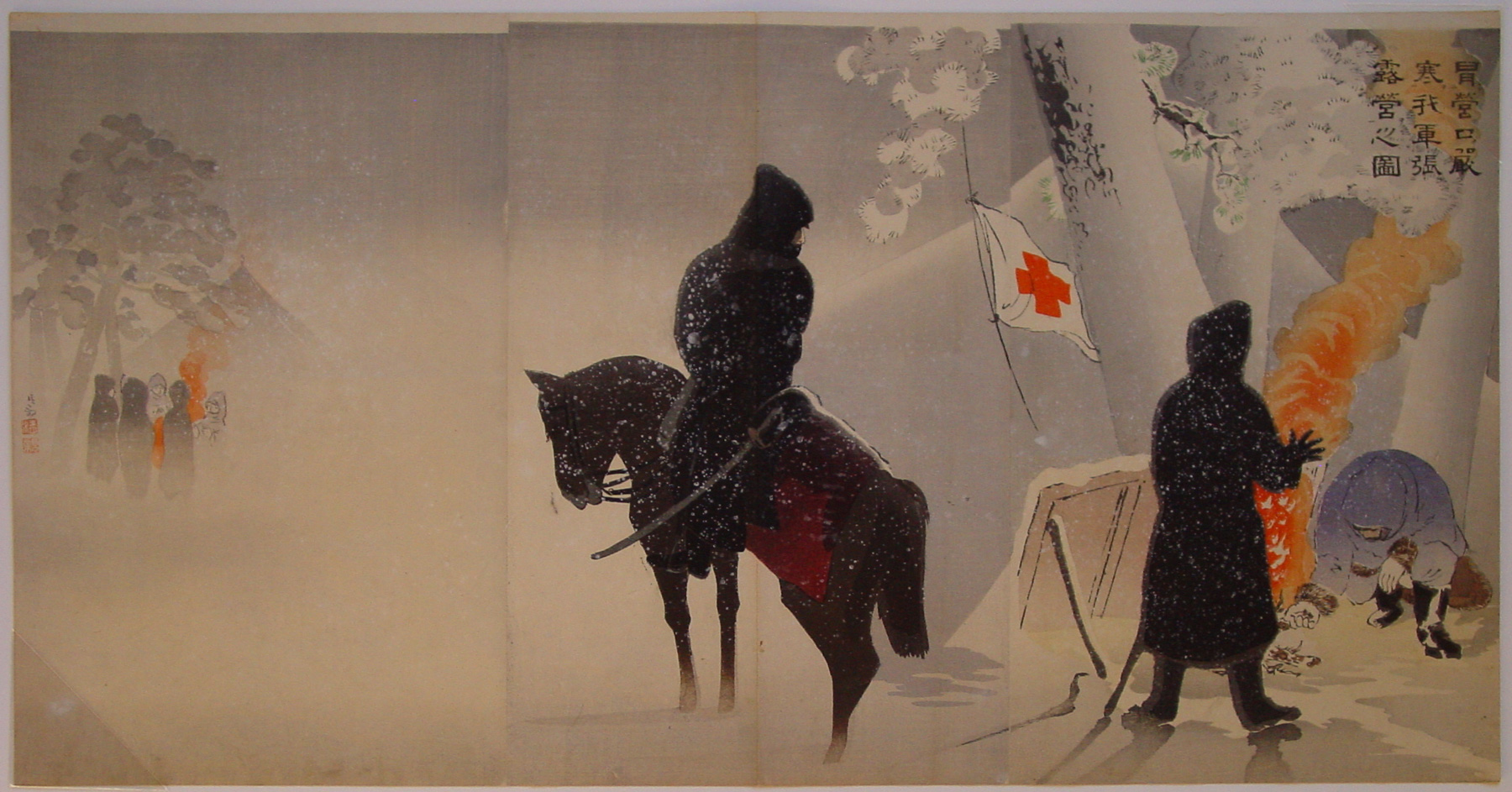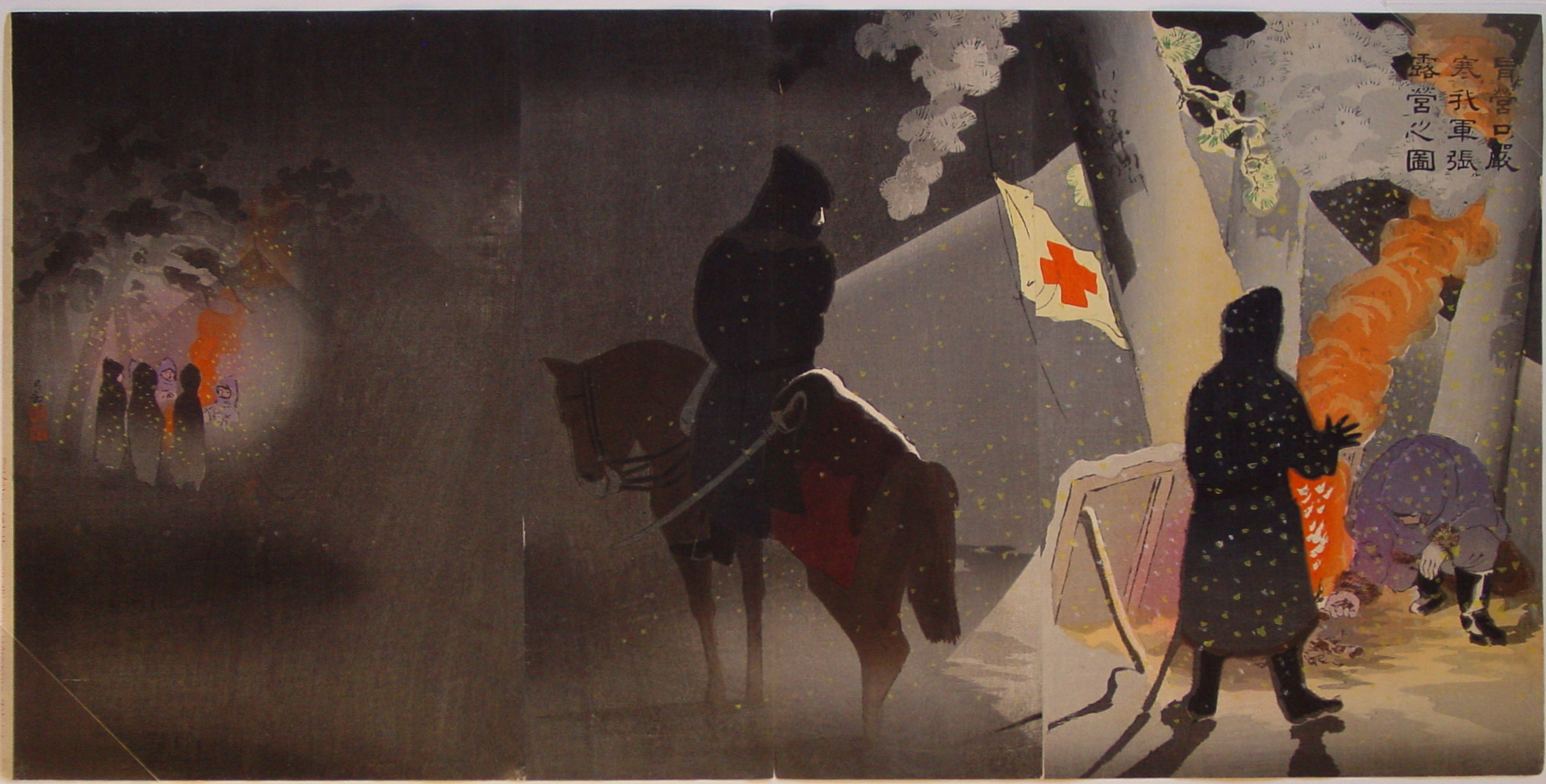About This Print
Soldiers and medical personnel are depicted gatheredaround campfires outside the tents of a Red Cross field hospital,anticipating the arrival of the wounded, in this 1895 print by KobayashiKiyochika, Braving the Bitter Cold, Our Troops Setup Camp at Yingkou.This print is usually seen printed as a dark night scene(IHL cat. 107) rather than as the illuminated scene (IHL cat. 100). Thesame blocks were used for both prints. The snow effect for bothprints was hand applied.
Source: Impressions of the Front, Woodcuts of the Sino-Japanese War, 1894-95, Shunpei Okamoto, Philadelphia Museum of Art, 1983, p. 9
The most effective of Kiyochika's Sino-Japanese war prints are night scenes in which one or more sources of light pick out lonely silhouettes. In the right-hand panel of this print of a bivouac in snow, one man kneels before a fire, which illuminates him, while another, his back to us, is a mere silhouette in shades of gray flecked with falling snowflakes. In the central panel, a mounted soldier, muffled against the cold, turns his head to the fire, and his profile is caught in the light. In the left-hand panel, a distant group of figures stands around another fire, their solitariness emphasized by the great area of blackness between them and the man on the horse, but their comradeship suggested by the light they share. Perhaps because it does not report on a particular event or the deeds of a specific heroic soldier, this one of Kiyochika's most affecting triptychs.
The most effective of Kiyochika's Sino-Japanese war prints are night scenes in which one or more sources of light pick out lonely silhouettes. In the right-hand panel of this print of a bivouac in snow, one man kneels before a fire, which illuminates him, while another, his back to us, is a mere silhouette in shades of gray flecked with falling snowflakes. In the central panel, a mounted soldier, muffled against the cold, turns his head to the fire, and his profile is caught in the light. In the left-hand panel, a distant group of figures stands around another fire, their solitariness emphasized by the great area of blackness between them and the man on the horse, but their comradeship suggested by the light they share. Perhaps because it does not report on a particular event or the deeds of a specific heroic soldier, this one of Kiyochika's most affecting triptychs.
Source: In Battle's Light: Woodblock Prints of Japan's Early Modern Wars, Elizabeth de Sabato Swinton, Worcester Art Museum, 1991, P. 49
The Red Cross flag on the tent suggests the heavy casualtiessustained by the Japanese while advancing across heavily mined openland in the campaign for the port of Yingkou (in modern Liaoningprovince near Gaiping). Because of these losses, the Japanese armyhalted and waited for night. Two feet of snow covered the ground andthe cold was severe, but the Japanese took Yingkou by March 9, 1895.
Heavily dependent on traditional woodblock styles, which usepattern-making areas of color to define form, the artist uses lightfrom separate campfires as well as the grain of the woodblock to conveythe isolation of the troops in the cold and swirling snow. Kiyochikadiffers from his predecessors, however, in his ability to integrate thefigures into the pictorial space by enveloping them in an atmospherecreated by the modulation of black ink tones.
In early March 1895, the Japanese fleet startedbombarding the coastal batteries of Yingkou, a vital seaport thirty-twomiles southwest of Newchang. The flat land approach was mined andprovided no cover for the advancing Japanese, who were also constantlyshelled from the citadel. After losing many men, the Japanese haltedand waited for the night’s cover. Although the bitter cold became moresevere in the night, the engineering corps, in a heroic effort, managedto clear the approach of trip wires and disarm the mines. Thestronghold was conquered from March 7 to 9.
Print Details
The Red Cross flag on the tent suggests the heavy casualtiessustained by the Japanese while advancing across heavily mined openland in the campaign for the port of Yingkou (in modern Liaoningprovince near Gaiping). Because of these losses, the Japanese armyhalted and waited for night. Two feet of snow covered the ground andthe cold was severe, but the Japanese took Yingkou by March 9, 1895.
Heavily dependent on traditional woodblock styles, which usepattern-making areas of color to define form, the artist uses lightfrom separate campfires as well as the grain of the woodblock to conveythe isolation of the troops in the cold and swirling snow. Kiyochikadiffers from his predecessors, however, in his ability to integrate thefigures into the pictorial space by enveloping them in an atmospherecreated by the modulation of black ink tones.
Attack on Yingkou
Source: Impressions of the Front, Woodcuts of the Sino-Japanese War, 1894-95, Shunpei Okamoto, Philadelphia Museum of Art, 1983, p. 32In early March 1895, the Japanese fleet startedbombarding the coastal batteries of Yingkou, a vital seaport thirty-twomiles southwest of Newchang. The flat land approach was mined andprovided no cover for the advancing Japanese, who were also constantlyshelled from the citadel. After losing many men, the Japanese haltedand waited for the night’s cover. Although the bitter cold became moresevere in the night, the engineering corps, in a heroic effort, managedto clear the approach of trip wires and disarm the mines. Thestronghold was conquered from March 7 to 9.
Print Details
| IHL Catalog | #100 and #107 | ||
| Title or Description | Braving the Bitter Cold, Our Troops Setup Camp at Yingkou [also translated as Our Troops Set Up a Bivouac at Yingkou while Braving the Bitter Cold] Eikō no genkan o okashite waga gun roei o haru no zu 冒営口厳寒我軍張露営之図 | ||
| Series | | ||
| Artist | Kiyochika Kobayashi (1847-1915) | ||
| Signature |
| ||
| Seal | kiyo 清 (top) and chika 親 (bottom) | ||
| Publication Date | 1895 (Meiji 28) | ||
| Publisher | Matsuki Heikichi (松木平吉) proprietor of Daikokuya, Nihonbashi-ku | ||
| Edition | Rhiannon Paget in "Conflicts of Interest...", p. 142 notes "The design was originally published without a title in January 1895. The title was added when it was re-released in March." | ||
| Engraver | Seikodo | ||
| Impression | #100: excellent #107: excellent | ||
| Colors | #100: excellent #107: excellent | ||
| Condition | #100: good - panels joined together, backed, slightly soiled, a vertical center fold on the middle panel; left margin (with inscription) trimmed #107: good - panels joined together, backed, slightly soiled, a vertical center fold on the middle panel; left margin (with inscription) partially trimmed | ||
| Genre | ukiyo-e; senso-e | ||
| Miscellaneous | #107 provenance was identified as from the Robert O. Muller estate. "Made in Japan" stamp verso. | ||
| Format | vertical oban triptych | ||
| H x W Paper | #100: 14 1/4 x 27 3/8 in. (36.2 x 69.5 cm) #107: 13 7/8 x 27 3/4 in. (35.2 x 70.5 cm) | ||
| H x W Image | |||
| Literature | Impressions of the Front, Woodcuts of the Sino-Japanese War, 1894-95, Shunpei Okamoto, Philadelphia Museum of Art, p. 32, pl. 44; Japan at the Dawn of the Modern Age – Woodblock Prints from the Meiji Era, Louise E. Virgin, Donald Keene, et. al., MFA Publications, 2001, p. 96, pl. 48; In Battle's Light: Woodblock Prints of Japan's Early Modern Wars, Elizabeth de Sabato Swinton, Worcester Art Museum, 1991, p. 49, pl. 22; Shinseimen o hiraita Meiji ukiyoe ten: Kiyochika, Yoshitoshi, Kunichika: Takahashi korekushon / [shusai Nihon Ukiyoe Kyokai, Rikkā Bijutsukan, 1973 (Catalog of an exhibition held at Rikka Bijutsukan, July 3-Aug 12, 1973, fig. 81, 82; Conflicts of Interest: Art and War in Modern Japan, Philip K. Hu, et. al., Saint Louis Museum of Art, 2016, p. 142, pl. 49.1 and p. 143, pl. 49.2 | ||
| Collections This Print | Smithsonian National Museum of Asian Art S2008.8.1349 (nighttime version); Museum of Fine Arts, Boston 2000.419 (nighttime version); Philadelphia Museum of Art 1976-75-104a--c (nighttime version); Museum of Modern Art, Kamakura & Hayama (ref. no. not provided); Saint Louis Museum of Art 133.2020a-c (nighttime version), 178-2010a-c (daytime version); National Diet Library 寄別8-5-1-2 (nighttime version); RISD Museum 1998.72.3A (nighttime version); Harvard Art Museums 1944.5.18 (nighttime version) |
last revision:
4/15/2020





